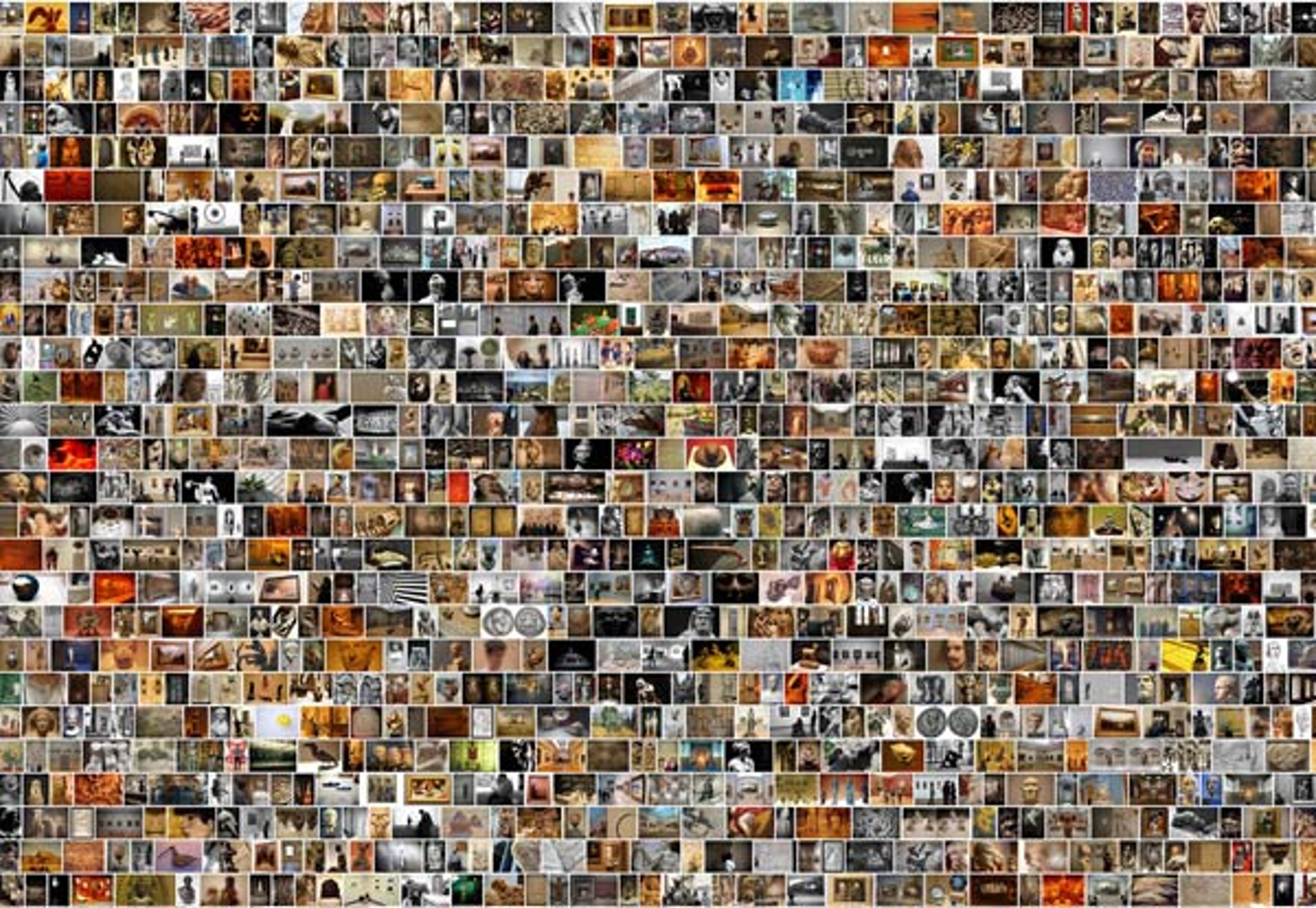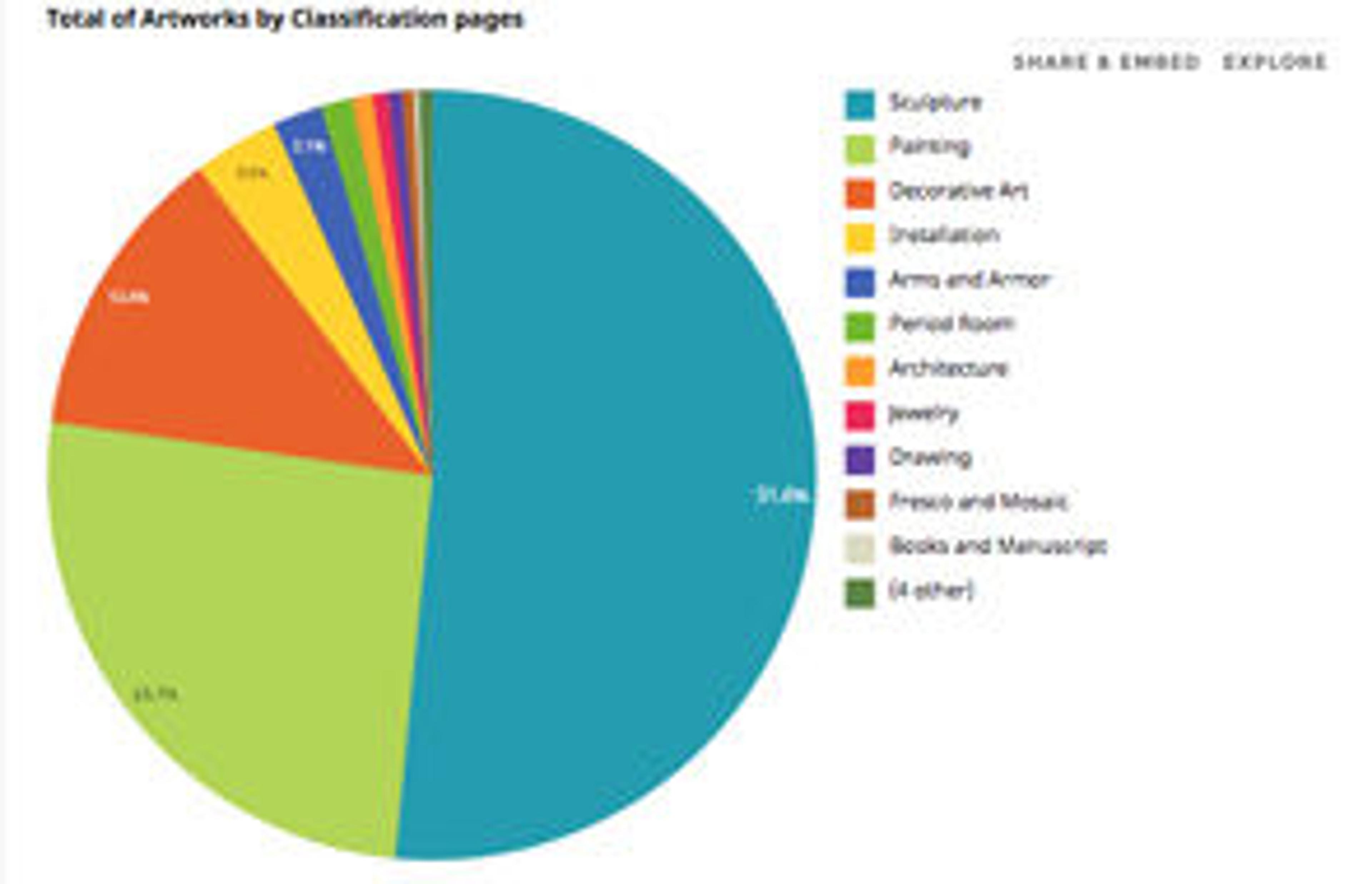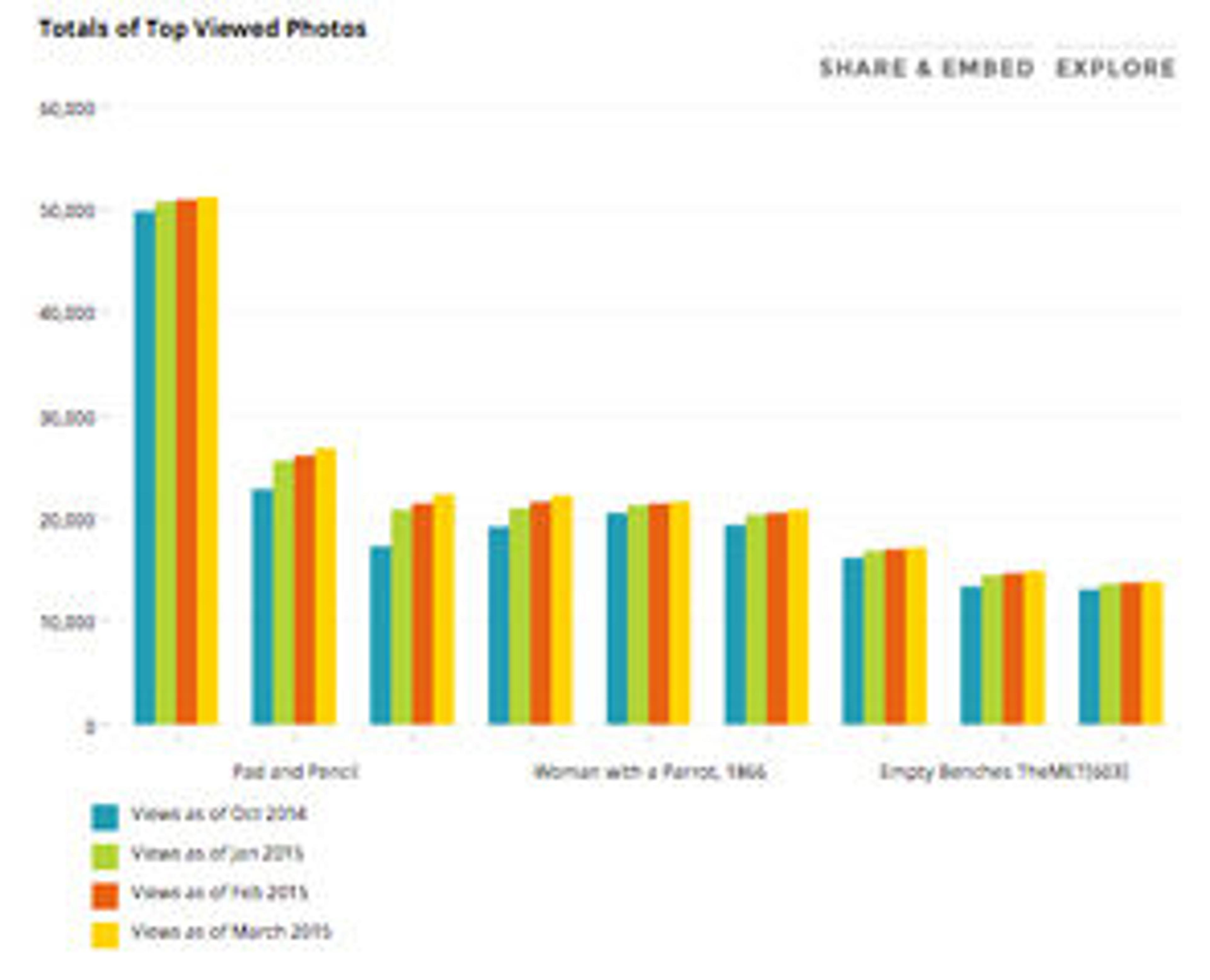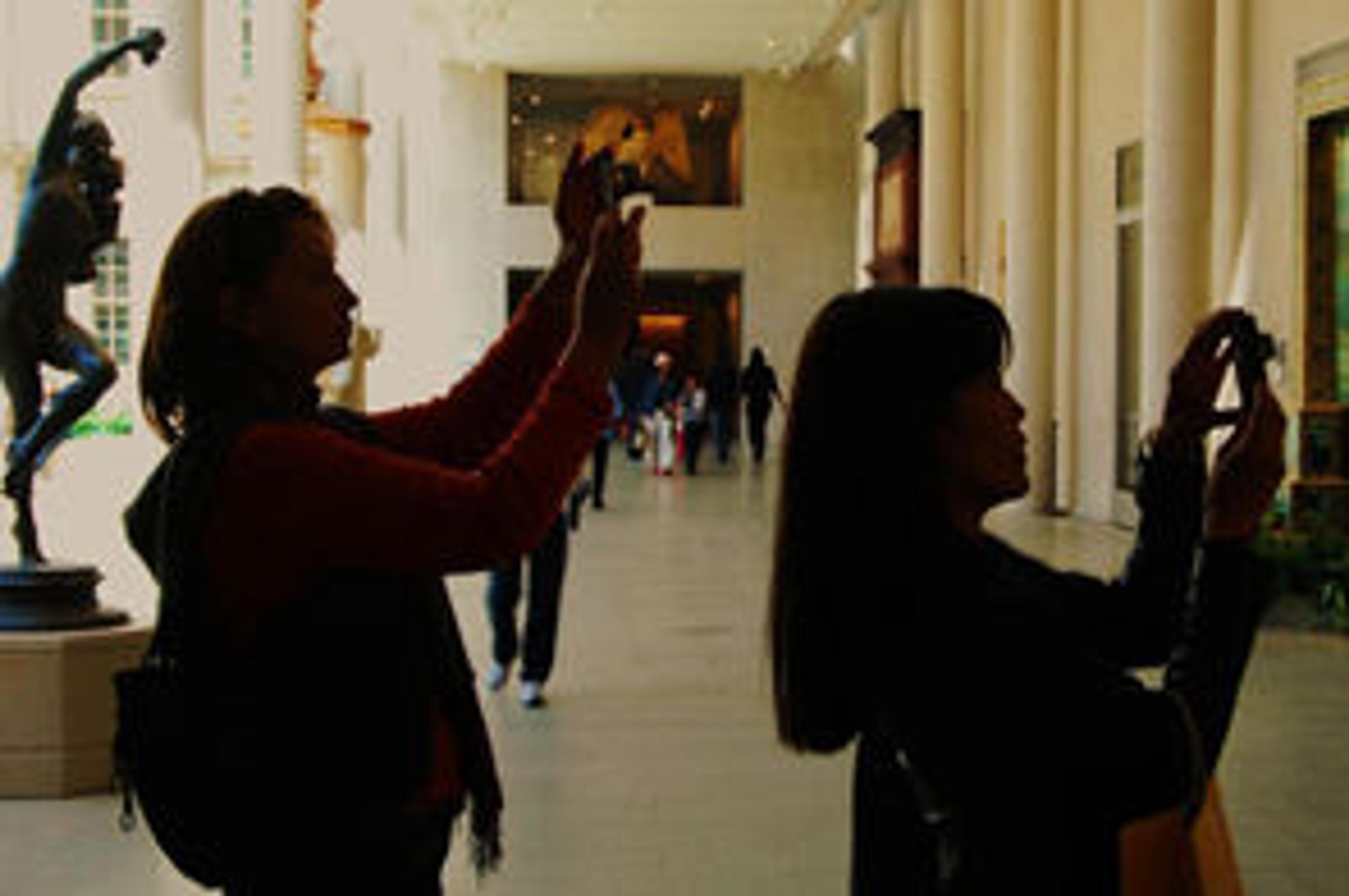Picturing Met Museum through Visitors' Eyes

Fig. 1. An array of photos from The Metropolitan Museum of Art Flickr group, created with ImageMontage
From Don Undeen, Senior Manager of MediaLab:
The Met's social media channels are a great way for our visitors from around the word to share their experiences and their mutual love for an encyclopedic art collection. For the Museum, it's a chance for us to see what really grabs their attention. Each photograph shared is a "like," but besides the art itself, what are our visitors liking—time with their families or wandering alone, relaxing in open courtyards or navigating a crowded, lively exhibition? We wonder if the building itself attracts as much attention as the artwork, and if we really have a "selfie problem." By analyzing a large set of data from our Flickr group pool, MediaLab volunteer Helen D. Wall was able to start unpacking these questions and more.
«The Met's Collection Online lets viewers browse through thousands of high-quality images of the Museum's vast holdings. Another rich depository of artwork images is the Museum's group pool on Flickr (a popular site for sharing photographic albums, with a free terabyte of online storage), where visitors post their own photos taken while touring the galleries. In this study, I took a closer look at what visitors were photographing and how they shared their photos online.»
Since it began in February 2008, the Met's Flickr group has grown, and is still growing, to over 2,400 members posting nearly 22,000 photos. While there is vigorous interaction with Museum followers on Twitter, Facebook, and Instagram streams, the Flickr group has its own unique dynamic that merges social interaction with creative expression. The main page displays the photos to full advantage and links to individual images and slideshows, many of which are high-resolution, since uploaded images are original size and uncropped, even panoramic shots. Titles and descriptions often have information or thoughts about what is shown, and comments, favorites, and views give feedback from other members, including invitations to post images to other like-minded groups.
Analyzing these images may provide answers to questions about the role of photography in the museum experience: Do visitors experience art in new ways by selecting and shooting what interests them; how are visitor-created photos different from museum-created archival images; and, how can a museum engage the visitor-photographer to enhance the experience?
For this study, a Python script was developed to download the dataset of 19,773 Flickr JPGs along with photo data, including title, description, date posted, views, tags, comments, and favorites. The files were organized and analyzed in the photo-management program Media Pro. A taxonomy, or hierarchical set of keywords, was developed that was specific to art and, in particular, to the Met Museum. This began with straightforward questions: Does the photo show an interior or exterior view, and does it show artwork? If so, is the piece two-dimensional or three-dimensional? If 2D, is it a painting, drawing, print, or photograph; or, if 3D, is it sculpture, architecture, period room, decorative art, jewelry, furniture, costume, or tapestry?
These progressed to more detailed questions: How are artworks photographed, in full view or close-up; is the artwork identified, either by the title or in the description; in which gallery or wing was the photo taken; if there are people in the photo, what are they doing—looking at art, resting, posing for pictures, or taking selfies; and, are the photos stylized in any way, such as colorized, collaged, shot in fisheye, or panoramic views?
By assigning museum-specific metadata to each image, the dataset was searchable by a variety of criteria. With the "Find" feature in Media Pro, displays could be filtered to show, for example, only images of paintings or of period rooms, all photos taken in a particular gallery, or any photos with people posing. These narrower subsets highlighted comparisons of like photos and revealed trends in photographing at the Museum.
Results
Of the 19,773 downloaded images, 17,638 (89%) depicted artworks, either as the primary subject of the photo, or in a gallery view. Of that total, only about 4,400 had title or description metadata that specified the artwork title or artist. With that information, accession numbers—or unique numbers assigned by the Museum—were assigned to the files. The accession number as embedded metadata served as an important link between the Flickr group pool and the Museum's Collection Online database. The list of artworks with accession numbers were processed through scrAPI, the public application programming interface developed by the Met for programmers to request and receive data in usable form.
With Museum-specific and Flickr metadata embedded in the JPG files, there was now a robust database in spreadsheet form for statistical analysis. This database was explored interactively online using Silk, a data-visualization and publishing platform, in Picturing Met Museum: A Study of Museum Visitors' Photographs, where the full set of visualizations can be seen. Two examples of the resulting visualizations, shown here, represent total number of images sorted by curatorial department, and the most-viewed images in October and December of 2014.


Left: Fig. 2. Silk visualization of images grouped by curatorial department. Right: Fig. 3. Silk visualization of top nine most-viewed images, October 2014–March 2015
Mapping the Flickr Group Pool
The array of Flickr images in Figure 1 was created with the free visualization tool ImageMontage, developed by Software Studies Initiative. Another macro, ImagePlot, was used to plot the images in date-created sequence across a 1280 by 860 pixel field representing the geo-locations of galleries where the photos were taken. The Museum floor plans were edited into the video using a bluescreen effect, and the full set of animations can be found on my Vimeo page.
Fig. 4. Animation of Flickr images mapped by X-Y gallery coordinates on the first floor area, created with ImagePlot.
Fig. 5. Animation of Flickr images geo-located on the first floor Museum map.
Fig. 6. Animation of Flickr images geo-located on the second floor Museum map.
Trends in the Photographs
The animations plot only a fraction of the total Flickr set, but they demonstrate the widespread practice of photo-taking across the entire Museum. The complete set of pictures serve as cinematic clips of the Museum tour, from wide-angle establishing shots to close-ups of the real stars, the artworks themselves. Naturally, the majority of the Flickr set is about the Museum's collection on display. Analyzing the framing of these photographs, what appears within their boundaries, reveals certain patterns of how artworks are depicted. A single piece can be shot in multiple ways, either in its entirety, a portion thereof, or in very detailed close-ups of its features, texture, or material. Shots taken in a gallery at a distance, with many artworks shown together, capture the three-dimensional context of a curated exhibition.
The Museum building itself assumes a prominent role as backdrop for many photos, from the glass-enclosed atrium of The American Wing to the Roman sculpture court. In seven percent of the Flickr set, attention is focused exclusively on capturing the geometry of skylit ceilings, archways, columns, fountains, on shadows falling across the floor, and views framed by expansive window walls. Photo favorites are of the Great Hall, with its vaulted ceiling, balconies, and Grand Staircase, as well as the classical Fifth Avenue facade and plaza, with its fountains, both as they once were as well as those recently installed.
These architectural photos are filled with people arriving, leaving, or milling around preparing for the visit. Being with other visitors is a vital part of the museum experience—when photographing inside the galleries, unless an artwork is shot up-close, it is a challenge to not include people in the scene. In these photos you see the vibrant or subdued activity in galleries and get a sense of scale of the artworks and the spaces they occupy. Sometimes people appear just as passersby or out of focus in the background, while other times they are the focal point: a couple studying a painting, someone leaning in to read the wall label, students with sketchpads. Visitors are seen studying the Museum map, checking their cell phones, or taking a break seated on benches, and sometimes we see another photographer caught in the act, or family members and friends posing for the photographer. Notably rare in this Flickr collection is the "museum selfie," where the camera is turned on one's self posing with the art. Instead, self-portraits appear as reflections in works like Anish Kapoor's Untitled stainless steel sculpture or the Roof Garden installation from Tomás Saraceno on the Roof: Cloud City.
Worth noting here is another way that visitors interject a personal touch into museum photography—the stylized photo made with creative image effects using built-in camera features or produced later with other software. Techniques include perspective-altering fisheye, panoramic views made with stitched JPGs, colorizing, pixelating, vignetting, multiple exposures, silhouettes, and sketching onto or collaging together images.


Left: "La Représentation Continue 1193 - Souvenir de New York - Avec le Chaunteur Espagnol, 1860." Posted by Afchine Davoudi. Right: "Three Ladies Clicking." Posted by Tim Schreier. See a slideshow of additional images from the Flickr group pool.
Next Steps
Metadata tagging of title, artist, and curatorial department of the remaining unidentified artworks is an ongoing process. One approach to expedite this could be a crowdsourcing toolset or campaign that elicits the expertise of the museum audience and communities. Ideally, it would be useful for visitors to capture information about artworks or exhibitions as part of the photo-taking process, or simplify adding the descriptive metadata after the visit. It would be worthwhile to explore emerging technologies such as augmented reality, beacons, and mobile apps or software that would facilitate access and link to the Museum's Collection Online database within and outside of the Met.
The images in the collection are one part of the Museum's Flickr group story. When 22,000 photos can generate over 7.6 million views, future investigations should include analyzing network relationships developed within the group and radiating out to the Flickr community at large. Many connections are made through invitations to submit photos to other groups. These cover a huge variety of subjects: museums and art galleries in general, specific art media, era (such as oil painting, medieval sculpture, and Etruscan places), photography styles, camera types, New York, travel, "best of" albums, and other novel specialty topics (such as metallic objects, benches of the world, and eagle lecterns).
Final Thoughts
The Flickr collection studied here represents a small fraction of the photographs taken in the Museum. According to a survey conducted in May 2014, of the Met's 6.2 million annual visitors, 50% percent will take photos while in the Museum. Whether shared through social media or stored on desktops or in the cloud, each photograph says, "I was there, I saw this"—a captured moment that can be revisited for years to come. The intention of this study has been to provide some insights into photo-taking as part of the Met Museum tour and suggest some next steps that will enhance the experience for participants both within and outside of the Met.
Acknowledgements
This research began as a Capstone study for my master's degree from New York University, and was further inspired by the big-data projects of Software Studies Initiative, led by Lev Manovich. To analyze the Met's Flickr collection, I was eager to apply techniques recently developed in the fields of big-data visualization, digital art history, metrics, mapping, and data publishing. By joining the Met's MediaLab for the fall 2014 term, I was able to expand the project, under the guidance of Senior Manager Don Undeen, to interact with a group of creative, tech-savvy interns and volunteers, and to gain access to Museum staff across various departments.
Special thanks to:
Don Undeen, Senior Manager of MediaLab,The Metropolitan Museum of Art
Taylor Newby, Social Media Manager, The Metropolitan Museum of Art
Lev Manovich, Founder and Director, Software Studies Initiative
Michael Anzuoni, Creative Technologist, Media Lab volunteer
Mehrdad Yazdani, Researcher Scientist, Software Studies Initiative
Salar al Khafaji, Co-Founder and CEO of Silk, and Silk team members Alex Salkever and Jurian Baas
Helen Wall
Helen D. Wall was formerly a MediaLab volunteer in the Digital Media Department. She earned a BArch at NJIT and an MA at NYU. In 2011, Helen founded Catalogue Digité, specializing in digital asset management, archiving, and research in the arts professions.